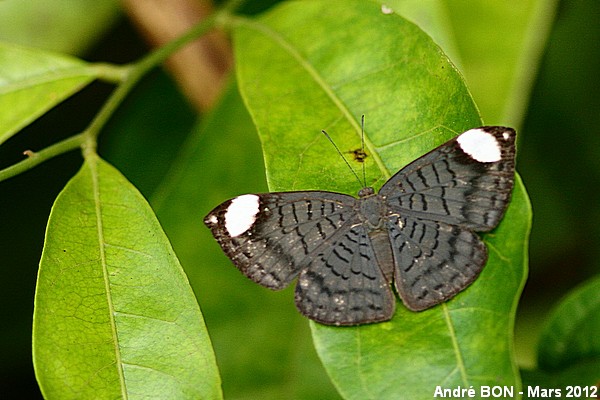
| White-patched Emesis (Emesis lucinda (Cramer, 1775)) |

|
|
Scientific name: Emesis lucinda (Cramer, 1775) Common name: White-patched Emesis Other names: Lucinda Metalmark French name: Order: Lepidoptera Suborder: Rhopalocera Family: Riodinidae Subfamily: Euselasiinae Wingspan: 35-40 mm. Biotope: Geographic area: From Mexico to Bolivia. Surinam, Guiana and Brazil. Flight time: All year round. Number of generations : Caterpillar: Very dark black body with a bright red head and a white rear tip. They shelter in group inside a kind of bag made with leaves loosely lined with silk. They move to the feeding place in a single row, one behind the other. Host plant: Neea psychotroides of the Nyctanginaceae family. |
You can easily recognize butterflies of the Emesis genus by the marking pattern and the shape of the wings. The wings are marked with tiny thin dashes and the tip of the fore wings is pointed. There are 41 species already described in this genus. The upper side of the wings of Emesis lucinda is very dark grey to blackish and marked with alignments of tiny black dashes. Females bear a large white spot next to the apex of the fore wings. The under side of the wings is beige on females and copper orange on males. It bears the similar dark markings than on the upper side plus one line of chevrons in the submarginal area. Here is the list of species which are known to be similar and may cause confusion (if my source of information is correct), Emesis eurydice, Emesis fastidiosa, Emesis castigata, Emesis liodes, Emesis aurimna, Emesis glaucescens and Emesis spreta. None of these species appear in the list of the butterflies of French Guiana. Here is some additional information, Emesis eurydice has straighter marks. Male Emesis fastidiosa bears a pale mark on the costal edge of the hind wings. |
| [To know more about the White-patched Emesis] [Top] |

|
I have shot this picture along the footpath starting from the Communal Hut on the Track of Sainte Élie. I did not take enough care of the bright white spots and so they are totally overexposed on this picture. I should have applied some exposure correction. These white spots indicate one female. |